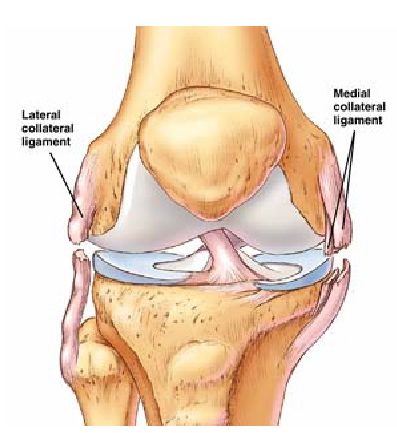
Two collateral ligaments link the leg bones that meet at the knee: a lateral one (on the outside portion of the knee) and a medial one (on the inside). While a tear of the lateral collateral ligament (LCL) is rare, a tear of the medial collateral ligament (MCL) is more common. Injuries of the MCL often accompany damage to the anterior cruciate ligament (ACL) and surrounding tissue.
Damage to the collateral ligaments usually involves significant force, such as a blow to the side of the knee during contact sports or a bad fall.

The MCL stabilises the inner side of the knee by connecting the upper leg bone (femur) to the tibia, one of two lower leg bones. The LCL stabilises the outer side by connecting the femur to the fibula, the other bone in the lower part of your leg. Together, the collateral ligaments control the side-to-side motion of the knee. If either ligament is stretched too far, it may tear.

Torn collateral ligaments usually occur during contact sports like football or hockey. A blow to the outside of the knee while the foot is planted can push the knee inward toward the opposite leg, tearing the MCL. A blow to the inside of the knee that forces the lower leg to bend out can damage the LCL.


You may experience pain, tenderness, swelling, and stiffness, followed by instability (the knee may give way and not support your body weight). If the torn ligament heals but is not strong enough to support the knee, you may experience chronic instability.

As discussed in the Diagnosis section of Arthritis and other Joint Problems, a history and physical exam will help the doctor make the diagnosis. Your doctor will order x-rays to rule out bone damage and a stress x-ray, which takes a picture of your leg pushed slightly outwards, to confirm a collateral ligament tear. An MRI scan can make the diagnosis, too.

The mainstay of treatment for most collateral ligament injuries is rest, ice, compression, and elevation (RICE). Resting the knee gives the ligament time to heal. Ice applied 2 or 3 times a day for 15 to 20 minutes may decrease pain and swelling. Compressing the knee with a bandage or brace can limit swelling, as can elevating the knee whenever possible.
You will also need to start a physical therapy program that includes exercises to restore range of motion and strengthen the thigh (quadriceps) muscle.
Most collateral ligament tears heal well with RICE and exercise. However, if the collateral ligament is completely torn or is accompanied by other injuries (like damage to the ACL), surgery may be required. The surgeon makes an incision in the area of the torn portion of the ligament. A ligament that's been pulled away from a bone is then reattached with sutures or a special staple. Chronic instability may need surgical reconstruction, which involves tightening up the loose ligament or replacing it with a graft.
You'll probably have to spend some time in the hospital. After repair or reconstruction, you'll start a physical rehabilitation program similar to the one used for patients who do not undergo surgery.
Illustration by: Calhoon, Borman, Mueller
|

